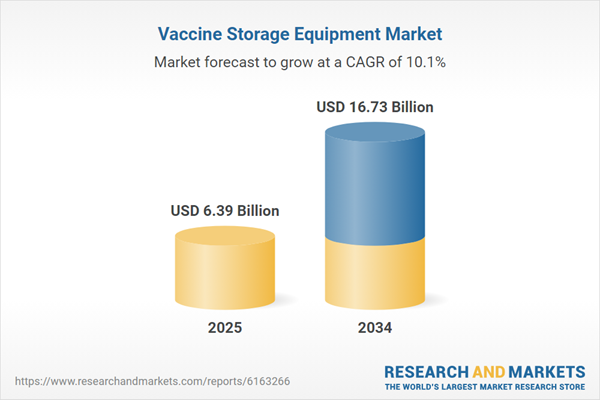Vaccine Storage Equipment: Introduction
Vaccine storage is related to the proper vaccine storage and handling practices from their development to the administration. The 2-8 °C cold chain is the industry norm for vaccine storage and delivery. In low- and middle-income nations, this is utilized for all currently licensed human vaccinations from the US Food and Drug Administration (FDA). There are some diseases like smallpox, chickenpox, shingles, and one of the measles, mumps, and rubella II vaccinations that are exempt from this rule and are transported between 25 °C and 15 °C. Some vaccinations, including the COVID-19 vaccine, need to be stored at a colder temperature of between 80 and 60 °C.Global Vaccine Storage Equipment Market Analysis
The market for vaccine storage equipment is witnessing significant growth driven by a combination of factors, including the initiatives of prominent organizations like UNICEF, which has strategically installed walk-in cold rooms across various regions, ensuring the quality and availability of vaccines. Initiatives like this majorly support the market expansion. Moreover, the Federal Government's efforts to establish a mega storage facility for vaccines in Nigeria will significantly enhance accessibility to vaccines which will directly contribute to the global vaccine storage equipment market growth.Collaborations such as the partnership between USAID and UNICEF have also played a crucial role by delivering vaccine refrigerators to support immunization campaigns in needful countries. The market is further influenced by innovative technological advancements, exhibited by the development of PHCbi brand pharmaceutical refrigerators and biomedical freezers. These advanced storage solutions are designed to meet the stringent requirements of high-value vaccines and biologics, offering reliability, uniform temperature control, and robust performance.
Additionally, the growing focus on research and development activities within the sector is contributing to the global vaccine storage equipment market share. An emerging trend is the increasing emphasis on needle-free vaccine delivery platforms, aimed at eliminating the need for frozen storage and improving global access to immunization. These trends collectively underscore the vaccine storage equipment market's dynamic landscape, driven by technological innovation, strategic partnerships, and an unwavering commitment to improving healthcare infrastructure on a global scale, further propelling the market growth.
Global Vaccine Storage Equipment Market Segmentations
Market Breakup by Product Type
- Bags, Vials, Ampoules
- Freezers
- Refrigerators
Market Breakup by End User
- Hospitals and Medical Institutes
- Distributor and Logistics
- Retailers
- Others
Market Breakup by Region
- North America
- Europe
- Asia Pacific
- Latin America
- Middle East and Africa
Global Vaccine Storage Equipment Market Overview
The global vaccine equipment market growth is driven by the increasing investments by healthcare institutions and biopharmaceutical companies in vaccine research and development. The increasing investments by the governments for immunization programs in several countries have been a major factor driving the market growth as well. The increasing prevalence of infectious diseases, especially after COVID-19 is further propelling the market growth. The market is also driven by the widespread vaccination campaigns conducted by international health organizations. The increased introduction of new vaccines in the market is also majorly supporting the market growth. The increasing technological development of storage equipment for vaccines is majorly contributing to the market growth.The rising awareness among people and healthcare professionals associated with early disease detection and prevention is also a major factor intensifying the market growth. The increasing focus of government on developing immunization programs to ensure the availability of enough vaccines for needful people is further responsible for the rising global vaccine equipment market share. The increasing investment in research and development activities and rising investments in biotechnological industry sectors for vaccine research are also among the major factors contributing to the market growth.
Global Vaccine Storage Equipment Market: Competitor Landscape
The key features of the market report include patent analysis, grants analysis, clinical trials analysis, funding and investment analysis, partnerships, and collaborations analysis by the leading key players. The major companies in the market are as follows:- Haier Group Corporation
- Philipp Kirsch GmbH
- Eppendorf AG
- Thermo Fisher Scientific, Inc.
- B Medical Systems
- Cole-Parmer Instrument Company, LLC
- PHC Corporation
- Helmer Scientific, Inc.
- Evermed S.R.L.
- Vestfrost Solutions
- American Biotech Supply
- Arctiko A/S
- Labcold
This product will be delivered within 3-5 business days.
Table of Contents
Companies Mentioned
- Haier Group Corporation
- Philipp Kirsch GmbH
- Eppendorf AG
- Thermo Fisher Scientific, Inc.
- B Medical Systems
- Cole-Parmer Instrument Company, LLC
- PHC Corporation
- Helmer Scientific, Inc.
- Evermed S.R.L.
- Vestfrost Solutions
- American Biotech Supply
- Arctiko A/S
- Labcold
Table Information
| Report Attribute | Details |
|---|---|
| No. of Pages | 350 |
| Published | July 2025 |
| Forecast Period | 2025 - 2034 |
| Estimated Market Value ( USD | $ 6.39 Billion |
| Forecasted Market Value ( USD | $ 16.73 Billion |
| Compound Annual Growth Rate | 10.1% |
| Regions Covered | Global |
| No. of Companies Mentioned | 13 |









